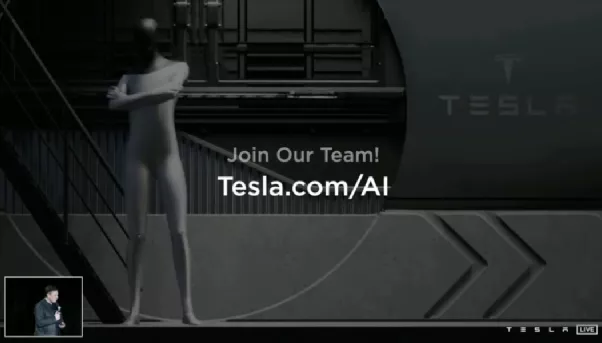Introduction
Today, Tesla AI DAY is making a grand appearance.
When Tesla first debuted in 2003, no one could have predicted the profound impact it would have on the global automotive market.
In 2016, Tesla’s acquisition of Solarcity launched a energy revolution behind Tesla. Those familiar with Tesla know that it is no longer simply an electric vehicle manufacturer, but an energy company. Tesla’s electric cars are just one part of Tesla’s huge energy storage empire. In China’s electric vehicle market, Ningde-era and BYD, both companies with significant energy storage layouts and businesses, are currently leading the way.
In 2019, Tesla introduced us to its self-developed FSD chip. While fully autonomous driving technology is still far away, we no longer doubt that it is already very close, especially in limited scenarios like highways.
In 2020, the 4680 battery + integrated chassis allowed us to imagine a Model 2 priced at only 160,000 RMB, which may be released in China at the end of the year.
The dreams that were once seen as impossible are being realized one by one. Will today’s AI DAY achievements also be realized one by one in the next 10 years, leading the development of the global automotive industry into a new cycle?
Supercomputer Dojo, Born to Be the Best
In 2019, Tesla abandoned NVIDIA chips and released its own self-developed chip with stronger computing power, causing a sensation around the world. The logic behind Tesla’s decision is simple: to let this chip specialize in autonomous driving. Today, Tesla is repeating its chip design strategy to achieve the best AI training performance possible. By using its exclusive AI training supercomputer, the deep neural network models can be equipped with greater efficiency and lower costs. This is the Supercomputer Dojo.
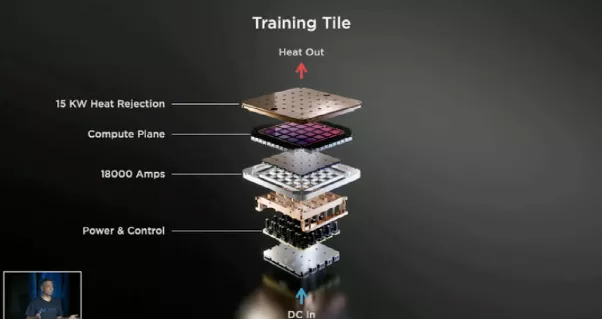
The core of Dojo is Tesla’s D1 chip, which is made with 7-nm technology and has a single-chip FP32 computing power of 22.6 TFLOPs. It is worth mentioning that the D1 chip’s on-chip bandwidth is 10 TB/s, and its off-chip bandwidth is 4 TB/s, far ahead of NVIDIA’s latest GPU products. Autonomous driving requires high bandwidth and low latency, and D1 chips will also greatly benefit Tesla in the field of autonomous driving in the future.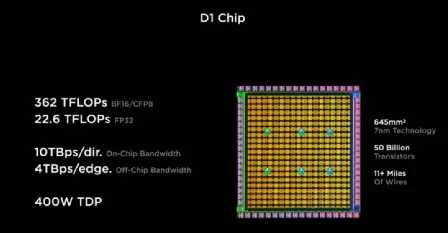
Based on this, Tesla put forward the concept of a training unit composed of 25 D1 chips. The interface of a training unit has a bandwidth of 36TB per second and computing power of 9 PFLOPS. It adopts centralized power supply and heat dissipation design, with a heat dissipation capacity of 15 kW. The Tesla cabinet model ExaPOD is equipped with 120 training units, 3000 D1 chips, and over 1 million training nodes. Its BF16/CFP8 computing power reaches 1.1 EFLOPS, which is the basis for Tesla’s future deep neural network learning.
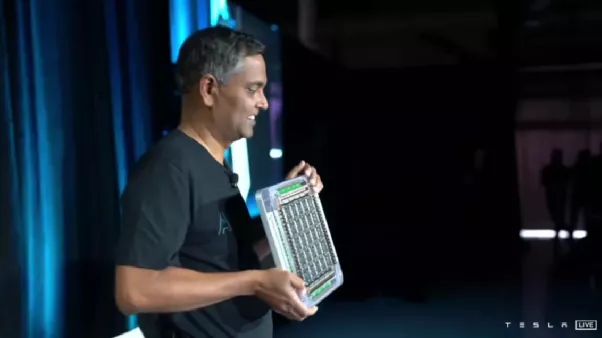
According to Tesla’s official statement, Tesla Dojo is the fastest AI training computer ever. Before Tesla built its own supercomputer, it had already built a world-ranked fifth supercomputer using NVIDIA GPUs. As a private enterprise, it can build two supercomputers at the same time. If combined with Elon Musk’s SpaceX company’s relentless exploration in space, we have to be amazed at its functional competence. What is even more surprising is that Tesla also revealed at AI Day that the performance of the next generation of Dojo supercomputer will be improved by 10 times based on the existing foundation, but Tesla did not disclose when this will happen.
Will Tesla Transform into a Robotics Company?
Robotics is also a hot topic today, but its limelight has been stolen by autonomous driving and new energy vehicles. The height of Tesla Bot is 5’8″, and its weight is 56.7 kg. Structurally speaking, the Bot’s whole body has 40 electric actuators. Bot’s eyes will be Autopilot cameras, and its body will carry FSD chips. The deep neural network architecture of multi-camera visual architecture, including planning, automatic labeling, simulation, Dojo training, and other technologies that Tesla is developing, will also be vertically integrated into the Bot robot. Functionally, Bot can pull 150 pounds (68 kg) or move objects weighing 45 pounds (20.4 kg). With its arms outstretched, it can hold objects weighing 10 pounds (4.5 kg) and has a top speed of 8 kilometers per hour, which can help people achieve some simple and repetitive labor.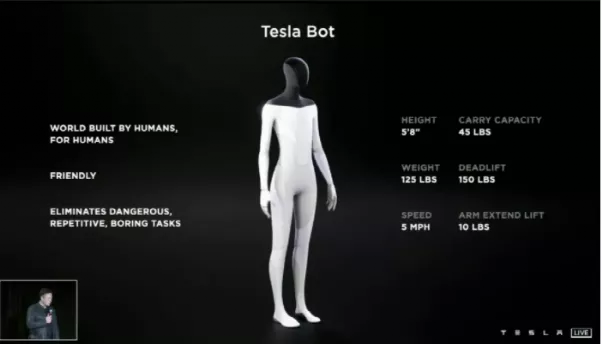
Perhaps there are still many unsatisfactory aspects of bots now, but in the future, bots will surely be able to achieve more possibilities through continuous optimization. After all, using robots to replace many repetitive labor is also a field with a very broad prospect. In the near future, we can pre-order a robot on Tesla’s official website to help us deal with various daily lives. judging from Tesla’s existing market value of 600 billion U.S. dollars, the robot industry may bring Tesla a new trillion-dollar market opportunity.
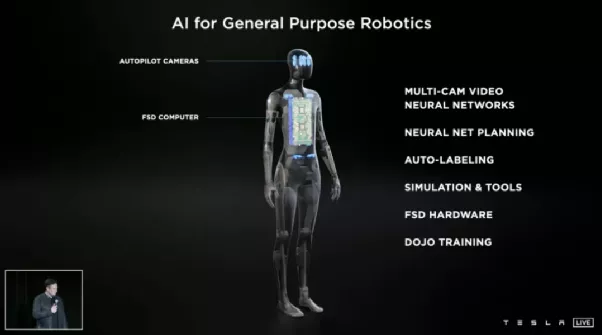
Autonomous driving also has new breakthroughs
Earlier, the NIO ES8 accident caused by the activation of NOP pushed the solution of autonomous driving/driving assistance without LiDAR to the limelight. As a car company that firmly does not use LiDAR in autonomous driving technology, and even cancelled the millimeter-wave radar of Model 3/Y sold in North America this year, Tesla also showed us its progress in pure visual recognition at this year’s AI DAY.
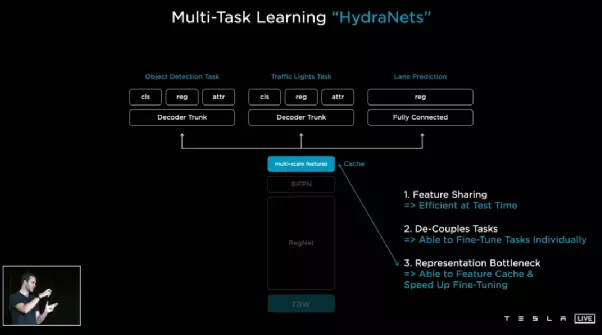
HydraNets multi-task learning network will use the “extreme simplification” approach to rebuild the FSD architecture.
After giving up the millimeter-wave radar, Tesla will rely entirely on the 8 cameras around the vehicle, adopting a 1280*960 resolution 12bit HDR image, collecting at a rate of 36 frames per second, and achieving perception of road scenes through the acquisition of 4D data based on time series. In more complex intersections, RNN recurrent neural networks will help Tesla predict and judge based on past experience, in order to achieve the goal of recognizing new road scenes. Experimental results also prove that FSD Beta9 has made great progress in recognition performance compared with Beta8, which is also the basis for Tesla’s confidence in canceling millimeter-wave radar.
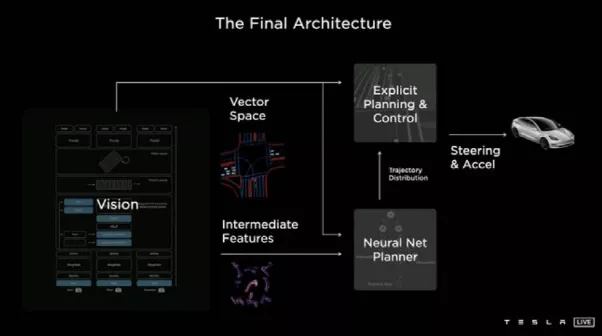 The labeled data is the foundation for Tesla’s FSD controller to perform deep learning. Tesla has also established a 1,000-person data labeling team. Currently, Tesla’s vehicle models around the world collect various data for it, and a large amount of data is generated every day. Moreover, as the labeling progresses from 2D to 4D, the entire labeling workload is significant. Tesla has therefore developed specialized automatic labeling software to help accelerate the annotation of relevant data.
The labeled data is the foundation for Tesla’s FSD controller to perform deep learning. Tesla has also established a 1,000-person data labeling team. Currently, Tesla’s vehicle models around the world collect various data for it, and a large amount of data is generated every day. Moreover, as the labeling progresses from 2D to 4D, the entire labeling workload is significant. Tesla has therefore developed specialized automatic labeling software to help accelerate the annotation of relevant data.
Today, Tesla may have shown us its ultimate goal: to become an artificial intelligence company. If the reinforced version of FSD demonstrated today still has a strong presence of an automaker, then the D1 AI training chip, the most powerful AI computing cabinet DOJO Pod, and the Tesla Bot robot all indicate that a brand new Tesla could appear before us in a few years. It is difficult for us to judge Tesla’s technological development from the perspective of an automaker, and perhaps the future of intelligent connected vehicles needs to be built on a foundation of strong artificial intelligence. Automotive enthusiasts, are we ready?
This article is a translation by ChatGPT of a Chinese report from 42HOW. If you have any questions about it, please email bd@42how.com.
